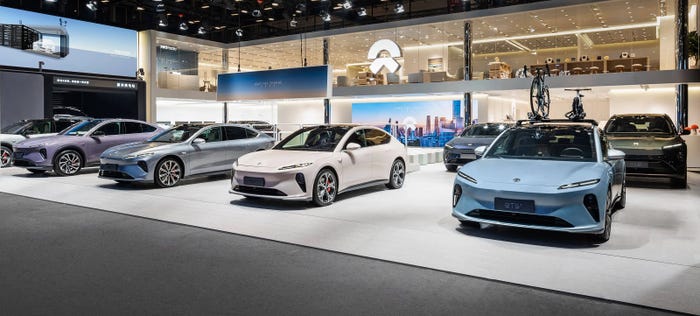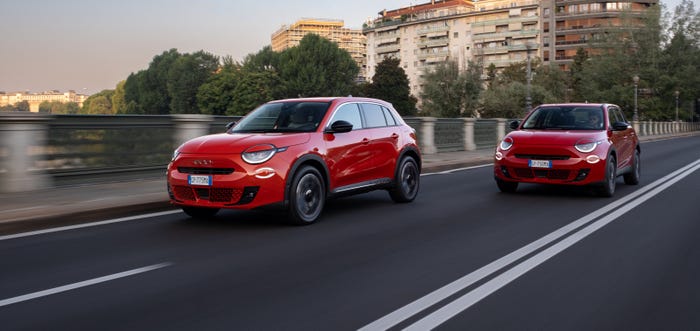Automaking in 2025 Japan
TOKYO - It's back to the future for the Japanese auto industry.Seventy-five years ago, in 1925, Ford Motor Co. arrived with a relief shipment of 1,000 Model-Ts, all knock-down and needing assembly, to help rebuild Tokyo's public transportation system which a year before had been severely damaged by a killer earthquake. General Motors Corp. landed the following year, and combined the two companies
December 1, 1999

TOKYO - It's back to the future for the Japanese auto industry.
Seventy-five years ago, in 1925, Ford Motor Co. arrived with a relief shipment of 1,000 Model-Ts, all knock-down and needing assembly, to help rebuild Tokyo's public transportation system which a year before had been severely damaged by a killer earthquake. General Motors Corp. landed the following year, and combined the two companies accounted for 95% of vehicle production over the next decade.
As the new millennium gets under way, Detroit's automotive giants are primed to re-enter the Japanese market, and by the quarter century mark, 2025, they could be major players again.
While crystal-balling is a dubious art, interviews with analysts and other industry observers have suggested some combination of the following as a possible scenario:
* There will be five large groups PLUS Honda Motor Co. Ltd. The largest will be headed by Toyota Motor Corp. and will include Daihatsu Motor Co Ltd. and Hino Motor Co. Ltd. as full divisions, not subsidiaries. Daihatsu will serve as Toyota's small-car engineering center; Hino, as today, will concentrate on trucks.
Overseas, Toyota will acquire BMW AG and, as part of its global strategic alliance with GM, will take over "platform" development for GM's ailing passenger car divisions - Buick, Oldsmobile and Chevrolet. As a condition for its support, Toyota will become part owner of Saturn Corp. and full owner of New United Motor Mfg. Inc., the pair's joint venture in Fremont, CA.
Nissan Motor Co. Ltd. and Renault SA will merge their operations globally, while fully integrating Nissan Diesel Motor Co. Ltd. as their heavy truck division to sell both Nissan and Renault brands. Fuji Heavy Industries Ltd., the focus of an intense bidding war in the early part of the century, eventually will join hands with Nissan and Renault, ultimately becoming the "Subaru" division.
Ford will acquire 100% equity in Mazda Motor Corp. and, with former Mazda president/now Ford CFO Henry Wallace as Ford CEO, will designate Mazda as the engineering center for Ford's worldwide lineup of compact cars, trucks and powerplants. Having lost out in the Fuji bidding, the U.S. automaker will move to acquire the minicar operation of Mitsubishi Motors Corp., including the Mizushima plant, in exchange for Volvo's continued participation in Netherlands Car BV, Mitsubishi's joint venture with Volvo in Born, the Netherlands.
Fiat Auto SpA, in search of a partner, will eventually extend Mitsubishi financial support (a la Renault to Nissan) in exchange for a minority equity position.
Then, after Mitsubishi restructuring is complete and the company is back on sound financial footing, the Mitsubishi group will help bail out Fiat in its home European market. The companies eventually will dissolve their relationship.
Some time after 2010, Daimler AG (Chrysler having been relegated to producing and marketing Daimler-engineered products for the American markets) again will seek to enter into a strategic partnership with Mitsubishi, hoping to pave the way for its belated entry into the Southeast Asian market, something the Chrysler acquisition failed to give it. To Daimler's chagrin, Volkswagen AG will beat it off the mark and gain overnight access not only to the Asian market but to the still powerful Mitsubishi industrial group.
GM will absorb Isuzu Motors Ltd. while raising its equity stake in Suzuki Motor Corp. to a controlling, though still minority, 49%. Isuzu, as the commercial vehicle and diesel powerplant development center for the GM group, will help propel the U.S. automaker ahead of Daimler to become the world's No.1 truck producer. Suzuki will serve as GM's small-vehicle unit.
All the while GM is expanding its presence in Asia through Isuzu and Suzuki, the company will continue to work with Toyota in the field of alternative fuel vehicles. Based on early linkages involving Toyota's "hybrid" Prius and fuel cell-powered FCEV, the pair will set the industry standard for hybrids and fuel-cell cars.
Honda will remain independent. Propelled by continued refinement of its VTEC engine technology and a long-awaited move into the pickup truck market, the company will see global sales grow to nearly 5 million units. By 2025, Honda, largely because of the popularity of its hybrid (part car/part truck) pickup, will find itself in a dead heat with Toyota as the top make in the North American pickup truck market.
* Production will hold steady at 9 to 10 million units per year with exports, mainly hybrid powertrain modules and integrated fuel-cell-system assemblies, accounting for 25% of output, or 2.5 million knock-down sets annually.
Finished vehicle exports will fall to 500,000 and consist mainly of niche products, including luxury sedans and sports cars.
Globally, the Japanese industry will produce as many as 40 million vehicles, fueled by growth in Asia, Latin America, the Middle East and Eastern Europe. They will score in these markets because of their early lead in "clean" powertrain technology and their ability to bring costs down to affordable levels.
In addition, with Honda and Suzuki taking the lead, they will launch a new series of mini 2-seaters, size-wise between a minicar and motorcycle and powered by a motorcycle engine with a pricetag closer to a motorcycle than a car. These will score big in emerging markets.
Toyota will be a close second to Ford in the global ranking, with Ford claiming the top position through a series of acquisitions around the turn of the century. Toyota, for the most part, will grow organically. GM will fall to third, in spite of significant growth in Asia, because of the decline of its sales base in North America. Ford and Toyota each will achieve global sales of nearly 10 million units.
Meanwhile, Japan's domestic demand will recover to the 7 million mark, though half of sales will be alternative-fuel vehicles - hybrids, fuel-cell cars and EVs - and the remainder will be "ultra-ultra" ULEVsfollowing Honda's continued lead in zero-level emissions technology.
In fact, Stephen Usher, senior auto analyst for Jardine Fleming Securities in Tokyo, believes that gasoline cars will be banned from downtown areas in the nation's largest cities. "In their place," he says, "will be fleets of compact electric cars, both 1- and 2-seaters, such as the Daihatsu Midget, Toyota e-com car and Nissan Hypermini that run semi-automatically."
On main thoroughfares, they will run automatically on "magnetic nails." On back streets and byways, they will be operated manually. For the most part, these midget EVs will be short-term rentals, all paid for by IC cards. "Taxis will no longer exist," Mr. Usher says.
Buses will, however. And all will run on some sort of advanced propulsion system or alternative fuel - including hybrid systems with direct-injection engines and/or CVTs, fuel cells, compressed natural gas, methanol and hydrogen gas.
The nation's commuter rail services will begin phasing in driverless "intelligent" hybrid buses to run in "pontoon" configuration beginning around 2015 or 2020. Industry executives claim that infrastructure costs associated with this sort of service are far less onerous than those for conventional rail services.
Aritsune Tokudaiji, influential automotive commentator and writer, adds: "In the future the driver will become like an 'autopilot' (system) in modern aircraft. Without question, automatic driving will be promoted on expressways."
Already, the industry, with considerable financial support from government, is investing heavily in ITS infrastructure and systems. Analysts expect these systems to become reality by around 2015, at which time the Japanese ITS market will grow to an estimated $70 billion annually.
"There's going to be an explosion in telematic applications," insists Lance Ealey, a consultant for the Cleveland Office of McKinsey & Co., who adds: "Japan, as the clear industry leader today, could cash in on this bonanza in multimedia and advanced safety technologies."
* Resulting from developments in telematics, all vehicles will be equipped with advanced safety supports including frontal-collision, lane-departure and pedestrian-warning systems. "Smart" air bags, both front and side, will be positioned at all seat locations in all cars. As a result, traffic fatalities will drop to less than half of current levels.
* Minicars in their current form will disappear as platforms and merge with the 1L to 1.3L segment cars. Or they will become hybrids that employ smaller than 0.66L engines, the current standard for minis. An early example of this, displayed at the 1999 Tokyo Motor Show, was Suzuki's battery-powered EV-Sport, a mini-roadster incorporating a supplemental 0.40L gasoline engine.
* On the sales side, traditional dealerships will no longer exist. They will become "virtual" driving centers where customers come to test-drive cars on simulators. Orders will be placed right into the factory making it possible for personalized cars to be delivered within a week.
Internet shopping, whether at the dealership or one's home, will account for the preponderance of vehicle sales.
Will driving become more fun? No, says Masafumi Suzuki, editor of Navi, a leading enthusiast magazine. "The traditional car and the act of driving will become like riding a horse, which today has limited transportation value and normally takes place at a special riding park or arena."
The first signs of this already can be seen. In 1997, Honda opened a test-driving facility and racing school in Motegi, Tochigi Prefecture.
The sprawling facility, named Twin Ring Motegi, features a range of practice courses including a 1.5-mile (2.5-km) high-speed circuit, 119-yard (200-meter) and 237-yard (400-meter) dirt tracks for trucks and RVs, and a special rut-filled course for motorcycles. Honda's objective in establishing the Motegi facility is to promote safe driving and motor sports.
Toyota's Amlux showroom in downtown Tokyo represents the future direction of automotive retailing in Japan. Under the same roof,one finds most Toyota products available in Japan. Customers, however, come to look, not to buy (sales are not allowed), while grabbing lunch or dinner at one of the showroom's restaurants on the top floor of its five-story building. For a small fee, visitors reportedly can test-drive all cars in Toyota's lineup.
Nissan has a similar showroom in Zama, Kanagawa Prefecture, at the site of the automaker's former assembly plant. Nissan reportedly hopes to attract 400,000 consumers annually. As at Amlux, visitors will be able to test-drive vehicles in Nissan's domestic product lineup on the premises, as well as buy car parts and accessories and have their cars repaired. It has been termed a "one-stop auto bazaar."
* Meanwhile, lifetime employment will continue in a de facto sense.
Demographic projections point to the onset of a severe labor shortage in Japan after 2010. Thus, although the total automotive labor force will shrink to 80% of current levels, there will be great demand for engineering and management staff. This labor shortage will force the industry to modularization, which will be aided by dramatic advances in metal forming and carbon composite and plastic molding technologies. By 2025, all Japanese cars will be built on single-shot aluminum or carbon composite frames.
* There will be five large groups plus Honda.
* Toyota will acquire BMW.
* Toyota will take over platform development for Buick, Oldsmobile and Chevrolet.
* Nissan and Renault will merge their operations globally.
* Fuji Heavy Industries will eventually join hands with Nissan and Renault.
* Ford will acquire 100% equity in Mazda and designate it as the engineering center for Ford's worldwide lineup.
* Ford will acquire the minicar operation of Mitsubishi in exchange for Volvo's continued participation in Netherlands Car BV.
* Fiat, in search of a partner, will eventually extend Mitsubishi financial support.
* Daimler AG (Chrysler being relegated to producing and marketing Daimler-engineered products in the American markets) will again seek a partnership with Mitsubishi.
* GM will absorb Isuzu while raising its equity stake in Suzuki Motor.
* Honda will remain independent.



